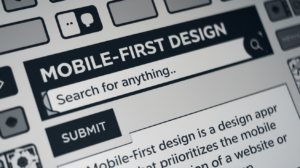
A well-executed redesign improves how your site functions, makes it easier to use across devices, and aligns your content with what people are actually searching for. It also helps your business stay competitive in an environment where speed, clarity, and accessibility make all the difference.
At Texas Web Design, we build websites that do more than look clean—they bring in qualified traffic, guide users with clarity, and turn visits into results.
If you’re not sure whether your current website still works for your business, contact us today. We’ll review what you have, show you where things may be falling short, and help you plan a redesign that actually moves the needle.
Why Redesign Your Website in 2025?
By 2025, a redesign is not just a visual refresh—it’s a full rebuild that helps your business keep up. The digital space is moving quickly, and if your site feels old, users may lose confidence in your business before they even read what you offer.
Customers now expect a fast, seamless experience. Outdated websites often appear less trustworthy and fail to meet today’s functionality standards. People want sites that are easy to use, mobile-friendly, and smart enough to personalize content or suggestions based on behavior. A redesign helps you meet those needs head-on.
Meeting Shifting Customer Expectations

For example, a local restaurant can stay relevant with real-time menu updates and smart suggestions based on previous orders or time of day. These modern features make your site feel useful and interactive, increasing the chances people will return.
Improving Online Appearance
If your site looks disorganized or outdated, it can hurt how people view your brand. With nearly all consumers—about 98%—turning to the internet to find businesses, your website is usually the first impression you make.
This is especially true for younger audiences like Generation Z, who are quick to judge based on design. A polished website shows that your business is active, relevant, and ready to serve its audience. A fresh design sends a clear message: your business is current and professional.
Turning More Visits Into Revenue
A modern website does more than look better—it works harder. With smart design and functionality, your site can attract qualified traffic and turn those visits into sales or leads.
Features like faster load times, clean checkout pages, and AI-driven chatbots reduce friction in the user journey. These improvements can lower cart abandonment rates in e-commerce and improve conversions for service-based businesses. The result? More value from your online presence.
Creating a Better Experience
Interactive tools like AR or quizzes increase engagement by making the experience more useful or fun. For instance, a furniture store can allow users to preview how products would look in their space.
That’s more than eye-catching—it helps people make decisions and builds trust in your products or services.
Staying Ahead in a Crowded Market
Planning a redesign now helps your business stay in step with the market. Voice search optimization and immersive content like AR/VR are gaining traction. Being early to adopt these features helps you stand out.
Whether you’re a local shop or a national brand, updating your website for these growing technologies keeps you from falling behind.
Highlighting Your Offerings Clearly
A clean design with high-quality visuals, easy-to-read descriptions, and simple navigation makes it easier to promote your latest products or services.
B2B service providers, for example, can add credibility by using video testimonials and case studies. These help build trust and guide leads through the buying journey.
Does Your Website Show These Red Flags?
Website designs are not just cosmetic. Here’s how to spot the signs that your site needs more than a fresh coat of paint.
Declining Website Traffic

Old SEO tactics or a lack of structured content can slow down growth. A redesign can help you reset and realign your content strategy to target high-value keywords and improve rankings.
High Bounce Rate
If users are landing on your site and quickly leaving, it’s a clear sign that something’s off. Research shows that when page load time goes from 1 to 3 seconds, the likelihood of bounce increases by 32%.
Clunky design, slow loading speeds, or confusing content may be pushing people away. Resolving these issues keeps users on the site longer and encourages them to explore.
Poor Conversion Rates
You may have traffic—but if users aren’t converting, your site isn’t doing its job. Weak calls to action, hard-to-use forms, or outdated design elements can create unnecessary friction.
Even small issues, like a misplaced “Contact Us” button, can affect how people interact with your business.
Outdated Functionality and Design
Sites running on outdated CMS setups or unsupported plugins often face security risks, performance issues, and compatibility problems. These issues impact both user experience and your credibility.
A design that looks outdated also makes users question whether your business is active or reliable.
Weak Mobile Performance
Over half of all web traffic now happens on mobile devices. If your site doesn’t function well on phones or tablets, users will leave. A mobile-friendly layout isn’t optional—it’s expected.
Modern responsive designs adjust to any screen size and make it easier for visitors to take action on the go.
Security Problems
Older websites are more likely to be targets for cyberattacks. Cyberattacks can occur due to unsupported software and outdated plugins.
Modern redesigns use current security protocols and best practices to keep your site and user data safe.
Content Is Hard to Update
If your site doesn’t let you update content quickly, it slows you down. A modern redesign includes a better content management system that makes it easier to post blogs, update product pages, or adjust services as your business evolves.
Weak SEO Performance
If your SEO strategy hasn’t been touched in years, your site is probably missing out on valuable traffic. New design structures, clean code, and optimized metadata can make a big difference in how your pages perform in search results.
Aligning Redesign With Your Business Strategy
Your website should reflect your business goals, not just your brand colors. When you plan a redesign, think about how the website can help you hit those goals—whether that’s more leads, more sales, or more bookings.
You’ll need clear structure, quick loading times, high-quality visuals, and logical calls to action that move users in the right direction.
Things to Keep in Mind During Planning
- Organize your content: Make it easy for users to move from one page to the next without confusion.
- Choose the right platform: WordPress offers flexibility; Shopify is ideal for e-commerce. Pick what matches your needs.
- Pick a short, relevant domain: Something easy to remember and aligned with your business name or services.
- Invest in reliable hosting: Fast loading speeds and consistent uptime help your site perform well under traffic.
- Design for mobile use: Smooth layouts and easy navigation across all screen sizes keep users engaged.
- Include clear call-to-action buttons: Whether it’s “Contact Us” or “Shop Now,” make the next step obvious.
- Use proven SEO tactics: Write content around the terms your audience is searching for and optimize all meta descriptions.
- Test everything before launch: Check for broken links, mobile display issues, and slow load times.
Ready for a Stronger Website in 2025?
A smart redesign helps your business connect better, convert more often, and stay prepared for what’s ahead. It’s more than a cosmetic update—it’s a way to improve performance, engagement, and visibility.
At Texas Web Design, we build websites that help businesses grow—fast, secure, and built for results. Ready to start?
Call us today to speak with a real person about your website redesign goals. Let’s build something that works for you—and keeps working.

